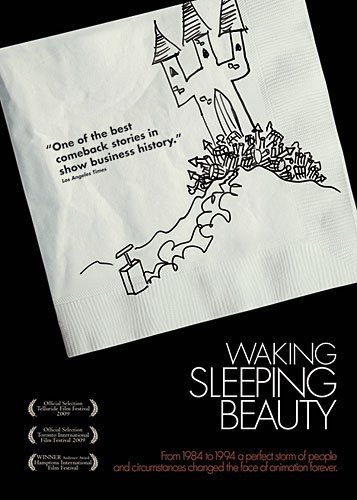
Waking Sleeping Beauty is a fascinating documentary about the renaissance of Disney animation that occurred during the 1980s and ’90s. Director Don Hahn, who has been involved with the studio in various capacities since the ’70s, tells the story through audio interviews from the people who experienced, which he paired with archival footage. Rather than present a glossed-over business biography, Hahn doesn’t shy away from the struggles and conflicts that occurred during the transition and presents a rich, compelling story.
After years of mediocrity that saw the studio nearly taken over by corporate raiders and lose talented artists like Don Bluth, 1984 saw Walt’s nephew Roy E. Disney bring in two successful movie executives to run the company. Michael Eisner from Paramount became CEO and Frank Wells from Warner Brothers became COO. Roy took over the animation department and Eisner brought in Jeffrey Katzenberg to run the film division.
There were growing pains. At first, the new didn’t bother to understand how the old worked and the old didn’t seem open to new ideas. Katzenberg cut The Black Cauldron and changed the name of The Great Mouse Detective fromBasil of Baker Street against animator wishes. There was plenty of blame to go around when neither did as well at the box office as needed, and Bluth’s American Tail outperformed the latter.
But as history reveals, Disney’s started to climb back up the mountain. They had success with Who Framed Roger Rabbit?; Oliver and Company,which took on Bluth’s The Land Before Time; and then 1989’s The Little Mermaid was the start of an amazing run. Beauty and the Beast was the first animated film nominated for Best Picture and it should have beatenSilence of the Lambs. Aladdin and The Lion King would also be stellar successes, yet all was not well behind the scenes as Hahn and the participants reveal.
The DVD comes with Bonus Features. The commentary by Hahn and producer Peter Schneider, who are joined by interviews of many of the people who appeared in the film, is well worth listening to because it makes the story even richer due to all the additional perspectives added. “Why Wake Sleeping Beauty?” (9 min) has Hahn and Schneider discuss making the movie.
There are six Deleted Scenes (35 min) that cover reworking Aladdin, research trips, Katzenberg’s farewell party, and three involving Howard Ashman dealing with his talents and his loss. “The Sailor, The Mountain Climber, The Artist & The Poet” (15 min) honors the four men who died that were very important to Disney’s resurgence: Roy E Disney, Frank Wells, Joe Ranft, and Howard Ashman. “Studio Tours” (13 min) from 1980, ’83 and ’90 are home movies by animator Randy Cartwright and John Lasseter of the Disney Animation Department building. “A Reunion” (2 min) pairs up directors Kirk Wise and Rob Minkoff have known each other since junior high and ended up working at Disney. “Walt” (6 min) honors the man who started it all.
Waking Sleeping Beauty is a great peek behind the curtain for those interested in how business and art work together. The film’s appeal goes beyond the Disney fan base and offers interesting lessons.